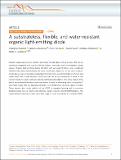Files in this item
A substrateless, flexible, and water-resistant organic light-emitting diode
Item metadata
| dc.contributor.author | Keum, Changmin | |
| dc.contributor.author | Murawski, Caroline | |
| dc.contributor.author | Archer, Emily | |
| dc.contributor.author | Kwon, Seonil | |
| dc.contributor.author | Mischok, Andreas | |
| dc.contributor.author | Gather, Malte C. | |
| dc.date.accessioned | 2020-12-07T17:30:02Z | |
| dc.date.available | 2020-12-07T17:30:02Z | |
| dc.date.issued | 2020-12-07 | |
| dc.identifier | 271169905 | |
| dc.identifier | 11d771d8-8fe4-4fad-a984-b001bbb90221 | |
| dc.identifier | 000598906000013 | |
| dc.identifier | 85097267485 | |
| dc.identifier.citation | Keum , C , Murawski , C , Archer , E , Kwon , S , Mischok , A & Gather , M C 2020 , ' A substrateless, flexible, and water-resistant organic light-emitting diode ' , Nature Communications , vol. 11 , 6250 . https://doi.org/10.1038/s41467-020-20016-3 | en |
| dc.identifier.issn | 2041-1723 | |
| dc.identifier.other | ORCID: /0000-0002-4857-5562/work/85168042 | |
| dc.identifier.other | ORCID: /0000-0003-4725-7404/work/85168565 | |
| dc.identifier.uri | https://hdl.handle.net/10023/21120 | |
| dc.description | This research was financially supported from the Leverhulme Trust (RPG-2017-231), the EPSRC NSF-CBET lead agency agreement (EP/R010595/1, 1706207), the DARPA NESD programme (N66001-17-C-4012) and the RS Macdonald Charitable Trust. C.K. acknowledges support from the Basic Science Research Program through the National Research Foundation of Korea (NRF) funded by the Ministry of Education (2017R1A6A3A03012331). C.M. acknowledges funding from the European Commission through a Marie Skłodowska Curie individual fellowship (703387). A.M. acknowledges funding through an individual fellowship of the Deutsche Forschungsgemeinschaft (404587082). M.C.G. acknowledges funding from the Alexander von Humboldt Stiftung (Humboldt-Professorship). | en |
| dc.description.abstract | Despite widespread interest, ultrathin and highly flexible light-emitting devices that can be seamlessly integrated and used for flexible displays, wearables, and as bioimplants remain elusive. Organic light-emitting diodes (OLEDs) with µm-scale thickness and exceptional flexibility have been demonstrated but show insufficient stability in air and moist environments due to a lack of suitable encapsulation barriers. Here, we demonstrate an efficient and stable OLED with a total thickness of ≈ 12 µm that can be fully immersed in water or cell nutrient media for weeks without suffering substantial degradation. The active layers of the device are embedded between conformal barriers formed by alternating layers of parylene-C and metal oxides that are deposited through a low temperature chemical vapour process. These barriers also confer stability of the OLED to repeated bending and to extensive postprocessing, e.g. via reactive gas plasmas, organic solvents, and photolithography. This unprecedented robustness opens up a wide range of novel possibilities for ultrathin OLEDs. | |
| dc.format.extent | 9 | |
| dc.format.extent | 2852456 | |
| dc.language.iso | eng | |
| dc.relation.ispartof | Nature Communications | en |
| dc.subject | QC Physics | en |
| dc.subject | TK Electrical engineering. Electronics Nuclear engineering | en |
| dc.subject | DAS | en |
| dc.subject.lcc | QC | en |
| dc.subject.lcc | TK | en |
| dc.title | A substrateless, flexible, and water-resistant organic light-emitting diode | en |
| dc.type | Journal article | en |
| dc.contributor.sponsor | US Department of Defence | en |
| dc.contributor.sponsor | European Commission | en |
| dc.contributor.institution | University of St Andrews. School of Physics and Astronomy | en |
| dc.contributor.institution | University of St Andrews. Sir James Mackenzie Institute for Early Diagnosis | en |
| dc.contributor.institution | University of St Andrews. Centre for Biophotonics | en |
| dc.contributor.institution | University of St Andrews. Biomedical Sciences Research Complex | en |
| dc.identifier.doi | https://doi.org/10.1038/s41467-020-20016-3 | |
| dc.description.status | Peer reviewed | en |
| dc.identifier.grantnumber | N66001-17-C-4012 | en |
| dc.identifier.grantnumber | 703387 | en |
This item appears in the following Collection(s)
Items in the St Andrews Research Repository are protected by copyright, with all rights reserved, unless otherwise indicated.

